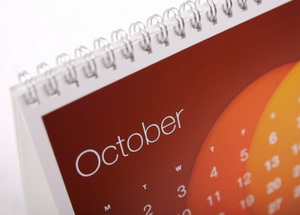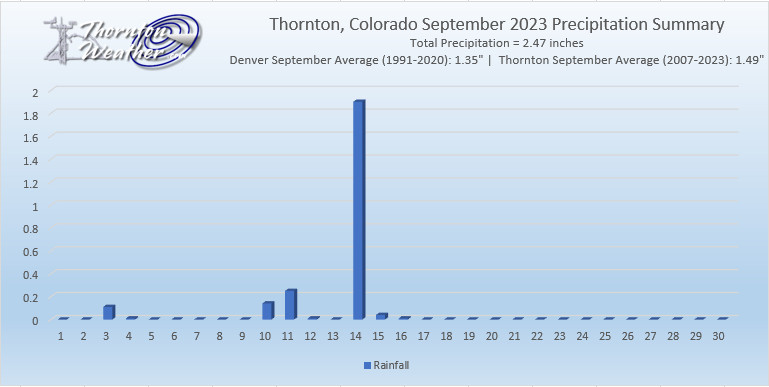
October is usually a relatively calm weather month in Denver but can see some interesting events. In our look back at this week in Denver weather history we see tornadoes, damaging wind and of course snow.
From the National Weather Service:
30-1
In 1959…heavy snowfall totaled 5.9 inches at Stapleton Airport. Winds were light.
1
In 1892…the highest temperature ever recorded in October… 90 degrees…occurred. This is also the latest 90 degree reading of the season.
In 1898…southwest winds were sustained to 40 mph with gusts to 49 mph in the city.
In 1927…a trace of snow was the only snow of the month… Ranking the year…amongst several other years…the second least snowiest on record.
In 1971…a wind gust to 90 mph was recorded at Buckley Field in Aurora. The severe winds caused damage in northeast metro Denver. A brick wall of a bowling alley was blown down…the roof was blown off a garage…and some business signs were damaged. A man in the bowling alley was injured by flying glass. Northwest winds gusted to 43 mph at Stapleton International Airport.
In 1994…unusually strong thunderstorms for so late in the season pummeled metro Denver with large hail. The largest hail…2 inches in diameter…fell at Buckley Field. Hail 1 3/4 inches in diameter fell 7 miles northeast of Boulder and at Niwot. Hail 3/4 to 1 1/2 inches in diameter fell in Boulder…Arvada…Wheat Ridge…Edgewater…capitol hill and northwest Denver…Bennett…and Strasburg. Hail of unknown size damaged a Boeing 737 aircraft and injured both pilots at Stapleton International Airport when the windshield was broken out on takeoff. Half inch diameter hail fell at Stapleton International Airport where northwest winds gusted to 40 mph and rainfall totaled 0.82 inch.
In 2014…severe thunderstorms produced wind gusts to 60 mph across parts of Arapahoe and Denver Counties. The intense wind gusts downed trees and power lines which caused a power outage near the Denver Technology Center. At Denver International Airport…a peak wind gust to 37 mph was measured from the northwest.
1
In 2020…extreme drought conditions continued in October. The first half of the month remained unseasonably warm… dry and windy. These conditions allowed the fires to the west and northwest of Denver to explode and double in size. The Cameron Peak wildfire become the largest in the state`s history. The Calwood wildfire in Boulder County started near Jamestown…and consumed 8788 acres within a 24-hr period on the 17th. It consumed a total of 10105 acres by the end of the month. The Calwood wildfire also became the largest wildfire in Boulder County history. The fire damaged or destroyed a total of 26 homes with preliminary damage estimates of nearly 37 million dollars. Extremely poor air quality continued to plague Denver and the entire Front Range.
2
In 1903…southwest winds were sustained to 42 mph with gusts as high as 60 mph. The strong Chinook winds warmed the temperature to a high of 78 degrees.
In 1910…an apparent dry microburst produced sustained northeast winds to 43 mph.
In 1934…a trace of rain was the only precipitation of the month. This was the driest October on record.
3
In 1875…very dense haze hid the mountains from view as observed from the city.
In 1933…rainfall of just 0.01 inch was the only precipitation of the month. This was the second driest October on record.
In 1954…the low temperature cooled to only 60 degrees…the all-time record high minimum for the month October.
3-4
In 1969…the first snowfall of the season totaled 16.0 inches at Stapleton International Airport. There was a thunder snow shower on the evening of the 3rd…but otherwise little wind with the storm. The greatest snow depth on the ground was 8 inches due to melting. Heavy wet snow accumulated on trees…which were still in full leaf…and caused widespread damage from broken limbs and downed utility lines.
3-5
In 1984…the remnants of pacific hurricane Polo produced heavy rain over northeastern Colorado. Most locations received between 1.00 to 2.50 inches of rain…but 3.45 inches fell in Littleton. Rainfall totaled 1.73 inches at Stapleton International Airport…where north winds gusted to 24 mph.
4
In 1912…sustained south winds to 55 mph with gusts to 60 mph raised the temperature to a high of 83 degrees… The warmest temperature of the month that year.
In 1924…west winds were sustained to 46 mph with gusts to 50 mph in the city. The apparent Bora winds cooled the temperature to a high of 57 degrees from a high of 70 degrees on the 3rd.
In 2004…several small tornadoes touched down near Brighton… Barr lake…and Hudson in Adams and southern Weld counties. Most of these caused no damage. However…a small tornado 5 miles southeast of Brighton caused extensive damage to a recreational vehicle and severely damaged a barn. The barn was torn from its foundation…and the roof was thrown 100 feet. Four llamas in the barn were injured when it collapsed.
4-5
In 1997…unusually warm weather resulted in two temperature records. High temperature of 87 degrees on the 4th exceeded the old record set in 1922 by one degree. High temperature of 86 degrees on the 5th equaled the record set in 1990 and previous years.
5
In 1962…unusually severe thunderstorms for this late in the season affected areas from Boulder northward. Hail up to golf ball size and strong gusty winds did much damage to roofs…windows…and signs in Boulder. Heavy rainfall caused local flooding.
In 1994…lightning caused a power outage to over 2400 homes for a few hours in and around Nederland in the foothills southwest of Boulder. Very strong winds accompanied the thunderstorm. Thunderstorm winds gusted to 60 mph and hail to 1/2 inch diameter fell in Lafayette. Strong microburst winds gusting to 69 mph near Strasburg caused an oil rig to topple onto two vehicles…injuring one person. The strong winds in the area also downed a few power poles… But caused power outages to only a few homes.
In 1995…strong winds spread from the foothills onto the plains. Wind gusts to 77 mph were reported atop Squaw Mountain west of Denver. On the plains…winds gusted to 60 mph at Kennesburg and to 62 mph near Strasburg. North winds gusted to 41 mph at Denver International Airport.
6
In 1900…northwest winds were sustained to 40 mph with gusts as high as 50 mph in downtown Denver.
In 1903…northwest winds were sustained to 40 mph with gusts to 50 mph. The strong winds warmed the temperature to a high of 71 degrees in the city. The low reading was only 46 degrees.
In 1910…light smoke from forest fires drifted over the city.
In 1976…an arctic cold front brought light snow over the foothills above 6 thousand feet. Traffic was snarled at many locations. Only a trace of snow fell at Stapleton International Airport where rainfall totaled 0.20 inch and northeast winds gusted to 41 mph.
In 1991…the brilliant orange sunset was apparently the result of an extensive volcanic smoke layer in the upper atmosphere.
In 1994…strong west to northwest winds developed in the foothills above 9500 feet. A wind gust to 78 mph was recorded atop squaw mountain west of Denver and to 72 mph at Ward northwest of Boulder. Northwest winds gusted to 35 mph at Stapleton International Airport.
In 2011… Strong winds developed in and around the Denver area ahead of an approaching storm system. At the National Wind Technology Center, peak wind gusts ranged from 79 to 92 mph during the early morning hours. Across metro Denver, the strong winds toppled a few trees and damaged patio furniture. The wind caused a few flight delays at Denver International Airport due to a partial ground stoppage of incoming flights. Peak wind reports also included: 66 mph at Cedar Point, 63 mph at Denver International Airport, 60 mph at Buckley Air Force Base; 59 mph at Highlands Ranch; 58 mph at Deer Trail and Rocky Mountain Metro Airport in Broomfield; 55 mph at Bennett, Centenniel Airport and City Park in Denver.
7
In 1903…north winds were sustained to 40 mph with gusts to 48 mph.
In 1917…post-frontal northwest winds were sustained to 45 mph with gusts to 52 mph. Rain was mixed with a trace of snow…the first of the season. Precipitation totaled 0.22 inch and included the occurrence of hail… Even though no thunder was heard.
In 1950…strong winds caused a power outage in Boulder. This was the heaviest windstorm since January. Damage was minor. Northwest winds gusted to only 35 mph at Stapleton Airport.
In 1985…strong Chinook winds buffeted the Front Range foothills. Wind gusts between 60 and 70 mph were reported in Boulder and atop Squaw Mountain west of Denver. Southwest winds gusted to 41 mph at Stapleton International Airport.
7-8
In 1990…the season’s first snow occurred. Snowfall amounts varied from 3 to 7 inches across metro Denver. Snowfall totaled 4.0 inches at Stapleton International Airport where north winds gusted to 29 mph.
 With the first full month of fall here, October usually brings one of the quietest weather months in the Denver area with plenty of mild, sunny days and clear, cool nights.
With the first full month of fall here, October usually brings one of the quietest weather months in the Denver area with plenty of mild, sunny days and clear, cool nights.





 Following an August that was unseasonably warm, we find ourselves heading into September hoping for relief. The month can bring plenty of rain and even our first snow of the season but more often than not, it is one of the most pleasant along the Colorado Front Range.
Following an August that was unseasonably warm, we find ourselves heading into September hoping for relief. The month can bring plenty of rain and even our first snow of the season but more often than not, it is one of the most pleasant along the Colorado Front Range.